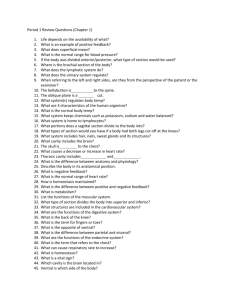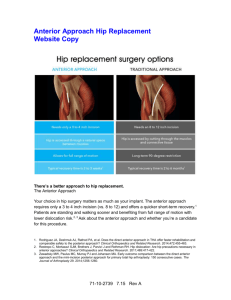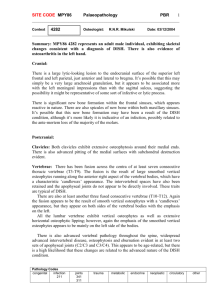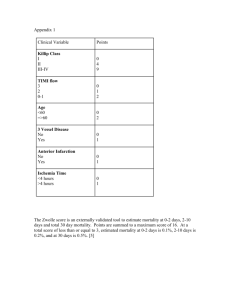A NEW FOSSILIFEROUS OUTCROP FROM THE BAJO BARREAL
advertisement
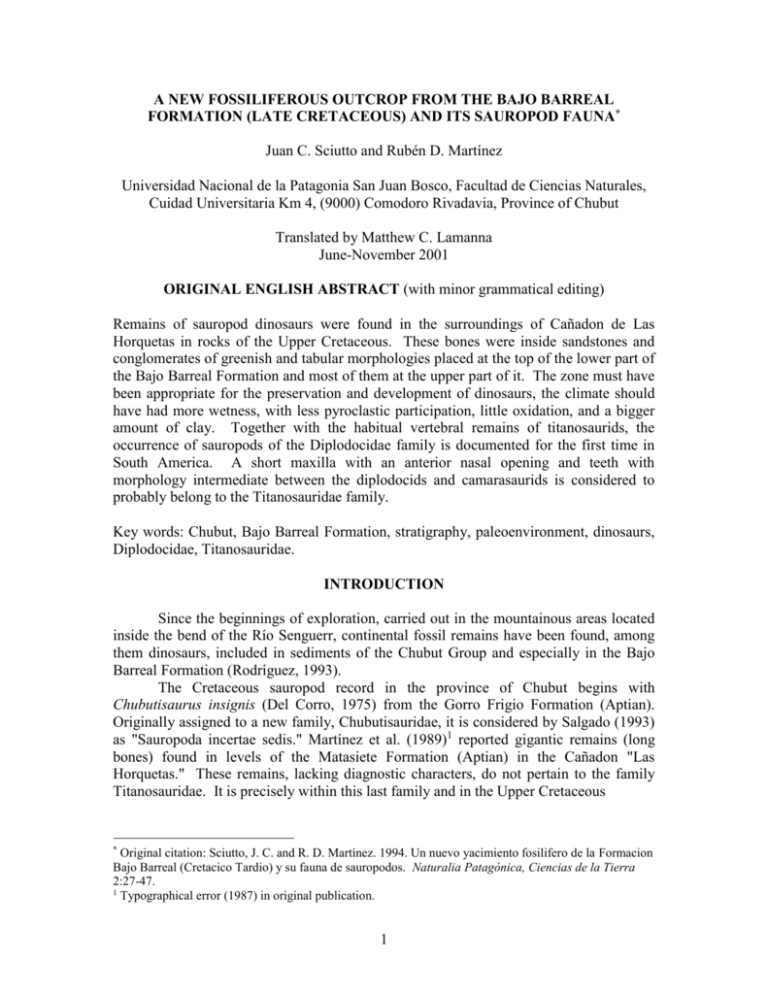
A NEW FOSSILIFEROUS OUTCROP FROM THE BAJO BARREAL FORMATION (LATE CRETACEOUS) AND ITS SAUROPOD FAUNA* Juan C. Sciutto and Rubén D. Martínez Universidad Nacional de la Patagonia San Juan Bosco, Facultad de Ciencias Naturales, Cuidad Universitaria Km 4, (9000) Comodoro Rivadavia, Province of Chubut Translated by Matthew C. Lamanna June-November 2001 ORIGINAL ENGLISH ABSTRACT (with minor grammatical editing) Remains of sauropod dinosaurs were found in the surroundings of Cañadon de Las Horquetas in rocks of the Upper Cretaceous. These bones were inside sandstones and conglomerates of greenish and tabular morphologies placed at the top of the lower part of the Bajo Barreal Formation and most of them at the upper part of it. The zone must have been appropriate for the preservation and development of dinosaurs, the climate should have had more wetness, with less pyroclastic participation, little oxidation, and a bigger amount of clay. Together with the habitual vertebral remains of titanosaurids, the occurrence of sauropods of the Diplodocidae family is documented for the first time in South America. A short maxilla with an anterior nasal opening and teeth with morphology intermediate between the diplodocids and camarasaurids is considered to probably belong to the Titanosauridae family. Key words: Chubut, Bajo Barreal Formation, stratigraphy, paleoenvironment, dinosaurs, Diplodocidae, Titanosauridae. INTRODUCTION Since the beginnings of exploration, carried out in the mountainous areas located inside the bend of the Río Senguerr, continental fossil remains have been found, among them dinosaurs, included in sediments of the Chubut Group and especially in the Bajo Barreal Formation (Rodríguez, 1993). The Cretaceous sauropod record in the province of Chubut begins with Chubutisaurus insignis (Del Corro, 1975) from the Gorro Frigio Formation (Aptian). Originally assigned to a new family, Chubutisauridae, it is considered by Salgado (1993) as "Sauropoda incertae sedis." Martínez et al. (1989)1 reported gigantic remains (long bones) found in levels of the Matasiete Formation (Aptian) in the Cañadon "Las Horquetas." These remains, lacking diagnostic characters, do not pertain to the family Titanosauridae. It is precisely within this last family and in the Upper Cretaceous * Original citation: Sciutto, J. C. and R. D. Martínez. 1994. Un nuevo yacimiento fosilifero de la Formacion Bajo Barreal (Cretacico Tardio) y su fauna de sauropodos. Naturalia Patagónica, Ciencias de la Tierra 2:27-47. 1 Typographical error (1987) in original publication. 1 that are registered the most numerous discoveries of sauropods from Chubut. Following the doctoral thesis of Powell (1986), the following genera can be considered as recorded in the province: Argyrosaurus, Aeolosaurus, (personal observation of an isolated caudal vertebra) and Epachthosaurus. While most of the remains of titanosaurs recorded in the province have been based on isolated vertebrae and long bones, the 1986 discovery of an articulated titanosaur, in outcrops of the Bajo Barreal Formation, only lacking a few dorsals, the neck, and the head (Martínez et al., 1989) had exceptional importance since it clarified many details of the structure of these sauropods that were unknown until then, for example the feet. This titanosaur was referred to the genus Epachthosaurus, previously described by Powell (1990) based on an isolated dorsal vertebra discovered in the same location. Soon after information on the existence of dinosaur remains in the Estancia “Los sauces” was obtained from Mr. Modesto Viviers, the Mesozoic vertebrate investigatory group of of the Laboratorio de Paleotologia de Vertebrados of the Universidad Nacional de la Patagonia San Juan Bosco of Comodoro Rivadavia organized, in execution of the project “The vertebrates of the Chubut Group: characteristics and evolution”, a series of field expeditions to this area. These excursions were carried out in December of 1990, January of 1991, February and November of 1992, and February of 1993. The exploration of the ample outcrops there provided the opportunity to also examine the neighboring ranch "La peligrosa" of the gentlemen E. Legari and R. Cambareri, located in the complete “Las Horquetas” canyon. The authors want to express their gratitiude to the authorities of the Facultad de Ciencias Naturales of the Universidad Nacional de la Patagonia and the company ASTRA C.A.P.S.A. for generous support granted for the development of this work. They also thank Mr. Gabriel Casal for his drawings and Mr. Marcelo Luna for his preparation of the fossil material. One of the authors (R. M.) thanks Dr. Jaime Powell for his critical reading of the manuscript. We extend our recognition to Fernando Novas, to the Viviers family, and to the gentlemen O. Legari and R. Cambareri that facilitated our work vastly with their generous hospitality. RESULTS AND DISCUSSION A. DESCRIPTION OF THE LOCALITY 1. LOCATION. The fossiliferous locality in the "Las Horquetas" canyon is located approximately at the 440 56' S and at the 690 22' W. (fig. 1). From Comodoro Rivadavia, one arrives at the sector of the locality located in the “Los sauces" ranch via provincial route 26 to Sarmiento and from there, to about 100 kilometers to the north via provincial route 24 that unites Sarmiento with Paso de Indios, then through the 11 kilometer track that leads to the head of the ranch. From there, one is approximately 7 kilometers to the west of the locality. 2 One arrives at the portion of the locality located in the "La peligrosa" ranch from Buen Pasto, traveling an estimated thirty kilometers by a path that goes into the ranch toward the east, until passing approximately only two kilometers from the sites. 2. STRATIGRAPHY. In the environment of the area treated here, Cretaceous and Tertiary continental sedimentary rocks in good exposures appear, often preserved by extensive coverings of flows of basaltic rocks, while more ancient units remain obscured in the subsurface, although they were detected by means of exploratory wells (fig. 2 and 3). The rocky exposures are clear although they do not possess abundant internal structures, which are important for the diagnosis of the genetic characteristics. The sedimentary units that bear osseous dinosaur remains belong to the Chubut Group (Cretaceous), comprised by the lower Bajo Barreal, upper Bajo Barreal, and Laguna Palacios, where their top is found partially eroded, by the Río Chico Formation (Paleocene). Although in the Cretaceous exposures several sections are identified, they may be grouped in 3 units, visually differentiable and with their own characteristics. From the oldest to the most modern important stratigraphic discontinuities are not observed but rather a gradual variation between them and a progressive migration of facies. Among their characteristics, the following stand out: a. Lower Bajo Barreal Formation (110 meters). For some authors this unit belongs to the high part of the "Serie de Castillo" (Ferello, 1950; Ferello and Tealdi, 1950). This unit consists of alternating gray and greenish tuffs. Gradually it incorporates sandstone banks, each time more frequent toward the top, showing an inverse megasequence and a composition each time more epiclastic in that direction. The presence of pumice clasts and scarce small bombs indicate the proximity of the explosive centers, which would have contributed the great quantity of pyroclastic material present in this unit. A gradual lithologic variation exists from the base to the top, passing progressively from: i. The base, constituted by massive tuffaceous mudstones and gray tuffs, deposited on a gentle slope; it could correspond to a continental floodplain environment. ii. In the central area, dominantly pyroclastic, clear brown tuffs prevail, with characteristic soil-forming zeolite-rich green tuffs and other green, laminated tuffs, suggestive of lacustrine environments. In the middle of this section small well preserved bones of a dinosaur were exhumed (J. Rodríguez, pers. comm.)2, coming from a greenish brown tuff, of kidneyshaped to almost spherical fracture, bioturbated (by roots?), directly under a conspicuous bank of green tuff, 1.5 meters thick, laminate, wavy, tabular, of lacustrine aspect and that 2 Several references to this specimen are made in this paper. It was described as the holotype of the small ornithopod dinosaur Notohypsilophodon comodorensis by Martínez (1998). 3 has regionality. This last is not the only stratum with these characteristics since other interbedded strata appear, under and on the same. Intercalated among these sediments, ephemeral sandstone beds appear, of pure and erosive base, fining-upward and of reduced lateral extension; disappearing to appear in other levels, alternating and with similar characteristics, that is to say, with little fluidity in the detritic movement, maybe as debris flows of high density and viscosity. These ephemeral fluvial courses would contribute sediment to the floodplains and the small lakes mentioned above. iii. The upper section is characterized by the presence of greenish sandstones and conglomerates that are arranged in tabular form inside greenish gray and gray tuffaceous mudstones and fine tuffs. Although they have a clear and erosive base, their tops are highly planar, similar to the G4 and G5 facies of Hechem et al. (1989). These sandstones have, in general, an important lateral extension, compared with those of the lower level, their internal structure suggesting an origin mediated by intermittent, rapid dense currents of short duration, where the source area would be in the vicinity or in nearby areas. Although they usually grade to fine sandstones and mudstones, with evidence of paleosols in the upper levels (covered, possibly by rains of volcanic ash of a few centimeters of thickness), in many cases the interruption of flow was quite rapid since there are frequent thick and clear ends. Internally they present variable transported structures in the vertical, although diffuse, from massive in the base, parallel stratification of high flow régime above and stratification intertwined in the top. These fining-upward cycles are superimposed several times and suggest a poorly defined drainage network defined on an apparently planar relief, where lagoons and lakes of little depth were located. Included in these sandstones that are not exclusive of the section, since they continue to appear in the upper member of the Bajo Barreal Formation, is where fossil remains of dinosaurs and other vertebrates have been found. This sector of the Bajo Barreal Formation, that comprises the top of the lower member and a great part of the upper member, is taphonomically controlled by rapid burial and also, it was more favorable for the development of these vertebrates, since the climate would have been more humid than that of the underlying sediments, according to what is indicated by the textural and structural characteristics of the sandstones, the low pyroclastic participation, low oxidation, and larger proportion of tuffaceous rocks altered to bentonitic clays (expansibles). b. Upper Bajo Barreal Formation (70 meters). It corresponds that denominated “Barreal Gris" of the internal reports of the investigators of Yacimientos Petroliferos Fiscales S. A. Usually appears semicovered by a scab of clayey weathering (regional characteristic). This is constituted by a repetition of cycles of 2 to 5 meters of thickness, between sandstones and gray and graygreen mudstone-tuff material. The lower sandstones have characteristics equal to those of the top of the member mentioned before (here, too, dinosaur remains are found). c. Laguna Palacios Formation (130 meters) 4 It is developed transitionally on the upper Bajo Barreal Formation. The Laguna Palacios Formation is differentiated from this last unit by its abrupt erosive morphology, conforming cornices and its characteristic banded yellowish ochre color. Lithologically it is constituted by reddish yellowish tuffites and yellowish gray tuffs that form wide horizontal planar surfaces or of very low depositional gradient, of subaerial exposure and/or paleosols. The scarce sandstones are gray and yellowish, interclastic, graded, of channels, and locally with evidence of eolian transport. These conspicuous soil-forming banks are developed starting from fundamentally pyroclastic sediments and only locally make it to expanses of epiclastics at the end of each gradational cycle; in this last case they result are shown by the abundant conduits left by the organic activity and they confer high porosity and permeability to the rock. That is to say that in this last unit of Cretaceous outcrop, different taphonomic and environmental conditions would be given, apparently unfavorable, for the development and preservation of dinosaurs. This progressive climatic change, from the lower Bajo Barreal Formation to the Laguna Palacios Formation, was not local but regional (or larger), since it can be visualized with similar characteristics, in this area, in the environment of the Laguna Palacios ranch, Sierra San Bernardo, as well as in a wide sector to the south of the Río Deseado, from Sierra España to the southwest of the locality of Las Heras, in Santa Cruz Province, areas that are separated, in some cases, by more than 300 kilometers of distance. 3. AGE OF THE SEDIMENTS. Since characteristic fossil remains of a determined age have not been found, and no radiometric dates were made in the environment of the area treated here, all that can be done for the moment is to analyze the existent stratigraphic relationships from a regional point of view. These sediments were deposited well above the Formation Pozo D-129, of possibly Aptian age (Musacchio, 1987; Chaia, 1987) and immediately under and in erosive, locally slightly angular discordant contact, with the Paleocene Río Chico Formation. The Laguna Palacios Formation is a facies variation of the upper section of the Bajo Barreal Formation (Sciutto, 1981). If this section is taken, from the outcrop to the subsurface and from here is spread to the length of the seismic lines toward the center of the Golfo San Jorge Basin, the same would laterally interfinger with sediments deposited almost at the end of the Cretaceous Period, below the regional transgression of the Salamanca Formation (Fitzgerald et al., 1992). This transgression was progressive and of engulfing and centrifugal form, producing gradually larger erosion as the sea expanded, but not initiating a large erosional or depositional hiatus among the sediments that are under and above this erosive surface, in particular, where the accumulation of the Chubut Group was continuous. Therefore, the sediments involved are here interpreted as deposits produced during the Late Cretaceous, probably Senonian. 5 It is convenient to clarify that radiometric dates in appropriate lithologies will be fundamental to achieve a more reliable and exact chronology in the future. B. PALEONTOLOGY The tetrapod fauna recorded to the present in the outcrops of the Bajo Barreal Formation in this locality, is the following: a. Chelonia (represented by a humerus). b. Crocodylia (known by scales and teeth). c. Ornithischia, a small ornithopod (represented by numerous bones “in situ”). d. Saurischia. Theropoda (documented only by teeth). Sauropoda. (diverse species documented by bones of the fore and hind limbs, cervical, dorsal, and caudal vertebrae, and teeth). It is examined here only those referred to the peculiar, by the presence of diplodocids, sauropod fauna recorded in this location. Order SAURISCHIA Seeley, 1888. Suborder SAUROPODMORPHA Huene, 1932. Infraorder SAUROPODA Marsh, 1878. Family TITANOSAURIDAE Lydekker, 1893. Subfamily TITANOSAURINAE indet. In the location numerous displaced caudal vertebrae are found, with the typical procoely of the Titanosauridae, but without more diagnostic features. However, a series of four anterior caudal vertebrae of modest size were found (UNPSJB-PV 584, 585, 586, and 587) whose neural spines, zygapophyses, and transverse processes are damaged (fig. 4). These vertebrae have centra anteriorly more wide than high and narrow ventral faces. Laterally the centra are concave in anteroposterior position. Discussion: In accordance with the classification proposed by Powell (1986) for the family Titanosauridae and keeping in mind the proportions of the centra and their tissue, these vertebrae are referred to the Subfamily Titanosaurinae. Family DIPLODOCIDAE indet. The material referred to this family is restricted to an anterior caudal vertebra (UNPSJB-PV 580) whose centrum (fig. 5) it is short anteroposteriorly with a concave posterior surface. The condition of the anterior articular face cannot be determined because it is damaged. In lateral view the vertebral centrum has the form of a spool, with a small and well defined pleurocoel with a partition, below the transverse processes. These last are aliform as in the diplodocids and dicraeosaurids (McIntosh, 1990). In the upper and lower ends of the transverse processes there is a thickening of the lamina that represents rudiments of the diapophysis and of the parapophyses (Hatcher, 1903). In anterior view, in the dorsal side of the centrum there is a large hollow located between the base of the transverse process and the border of the vertebral centrum. The neural arch is low. 6 The neural spine is remarkably high, since the preserved part measures more than twice the height of the centrum and is somewhat inclined caudally. In posterior view the strong suprapostzygapophyseal laminae that define a deep depression that conserves vestiges of the postspinal lamina stand out. The anterior surface of the spine is damaged and deformed although the prespinal lamina, anteroventrally bifurcated in spinoprezygapophyseal laminae, is observed. Discussion: This vertebra possesses diagnostic characters of the anterior caudal vertebrae of the family Diplodocidae, such as aliform transverse processes and the presence of pleurocoels (McIntosh, 1990). The dicraeosaurid sauropods, such as Amargasaurus cazaui (Salgado and Bonaparte, 1991) from Neuquén, although they have aliform transverse processes in the anterior caudals, lack pleurocoels (McIntosh, 1990; Salgado and Bonaparte, 1991) and are also robust and heavy (Salgado and Bonaparte, 1991) and not slight as is the caudal that is the object of this study. In Chubutisaurus insignis (Del Corro, 1975) from the Aptian of Chubut, the anterior caudals have an anteroposteriorly compressed centrum in a form comparable to the vertebra of the diplodocid from Chubut, but lack aliform processes and pleurocoels. On the other hand, the anterior caudal vertebrae of the Titanosauridae, including Andesaurus delgadoi (Calvo and Bonaparte, 1991) do not have similarities with the caudal in study. If we compare the vertebra from Chubut with equivalent material of diplodocids like Diplodocus or Apatosaurus we see that besides the aliform transverse processes and pleurocoels, the general morphology is very similar, such as the very high neural spine, the disposition of the zygapophyses and location of the transverse processes. Although the centrum of the caudal from “Las Horquetas" seems to have been amphicoelous and not procoelous as in the anterior caudals of the diplodocids, this character seems to present great variability as is demonstrated in the caudals of Apatosaurus louisae (Gilmore, 1936), the first seven of which are procoelous (with the convexity restricted to the lower part of the centrum) then become amphicoelous until vertebra number 34 where the posterior convexity appears again and in number 35 the vertebrae become biconvex until the end of the tail. Infraorder SAUROPODA indet. Two anterior dorsal vertebrae are present (UNPSJB-PV 581, 582). They were found "in situ" and nearly articulated (fig. 6). The centrum is small, opisthocoelous, with the internal tissue forming cells and the small pleurocoels. The neural arch is high with a small neural canal; on it, in anterior view, there are two well defined supraneural hollows separated by a strong bony lamina reinforced by lateral borders in the upper sector. The infraprezygapophyseal laminae are well developed and posteriorly on them a pair of deep prediapophyseal fossae exist. The prezygapophyses are located relatively high on the centrum and there are supraprezygapophyseal laminae. In these vertebrae the accessory hyposphene-hypantrum articulation is not present. The incomplete diapophyses are directed almost horizontally toward the sides. 7 In posterior view the articular surfaces of the vertebrae are markedly concave. Laterally in the neural arch the two infradiapophyseal laminae that define a deep triangular cavity are seen. The neural spine is incomplete but is simple and it seems to have been low, with undivided pre - and postspinal laminae and spinodiapophyseal laminae that widen in anterior view. In the two vertebrae the posterior part of the neural arch is very damaged, but in the more posterior dorsal vertebra the two supraneural fossae are preserved and in the more anterior dorsal vertebra there are two strong suprapostzygapophyseal laminae that define a well marked cavity between them, at the bottom of which there are traces of the postspinal lamina. Discussion: The systematic determination of these dorsal vertebrae is uncertain, but the features are clearly different from those in the dorsals of the sauropods of the family Titanosauridae, dominant in the Late Cretaceous of South America, with anteroposteriorly long vertebral centra and relatively low neural arches, without supraneural fossae and with centrodiapophyseal laminae (L. Salgado, pers. comm.). The simple neural spine is a character that has been replaced in the anterior dorsal vertebrae of diplodocids and dicraeosaurids by the bifurcated neural spine. In this case, we would have evidence of two groups of non-titanosaurid sauropods at this locality. On the other hand, the small and short vertebral centrum and the relatively delicate diapophyses do not agree with the anterior dorsals of diplodocids like Apatosaurus, Diplodocus, or dicraeosaurids like Amargasaurus. The robust centrum with enormous pleurocoels and the disposition of the laminae on the neural arch in Haplocanthosaurus (Hatcher, 1903) separate this sauropod from the “Las Horquetas” vertebrae. With Patagosaurus fariasi Bonaparte (1986), the differences are even more noticeable: large centrum with small pleurocoels displaced forward, very high prezygapophyses on the centrum and diapophyses with different morphology. The discovery of a sauropod in the Candeleros Member of the Río Limay Formation (Albian-Cenomanian), one that preserves abundant postcranial material (L. Salgado, pers. comm.), raises a different interpretation since it possesses anterior dorsal vertebrae with simple neural spines and amphicoelous or amphiplatyan caudals very similar to UNPSJB-PV: 581, 582. In the example of sauropod of the Río Limay Formation the presence of pleurocoels cannot be verified (L. Salgado, pers. comm.). Infraorder SAUROPODA Family TITANOSAURIDAE indet. It is left maxilla that is characterized by being a short bone (fig. 7), high in its anterior portion and narrow posteriorly (UNPSJB-PV: 583). The main body of the maxilla possesses teeth. The dorsal process of the maxilla is prominent and defines the anterior part of the rounded preorbital opening and more dorsally, the latero-anterior border of the nasal orifice. The main body of the maxilla presents an intact anterior extremity, including the surface for the articulation of the premaxilla. Posteriorly, the maxilla is incomplete. The upper end of the nasal ramus is eroded, but it allows one to locate accurately, keeping in 8 mind the intact surface of its anterodorsal border, the position of the nasal openings that were in a relatively anterior position, slightly anterior and dorsal to the preorbital opening. Laterally the surface of the maxilla is relatively flat, lacking foramina. Medially it presents a strong elevation that runs longitudinally and is where replacement teeth originate. There are eight dental alveoli and very close to them medially, the foramina for the germ teeth. There are no differentiated interdental plates. In at least two alveoli there are teeth in eruption, and in the first the tooth is broken, but allows its cylindrical structure to be seen, at least in its base. One of the erupted teeth has been extracted (the fourth from the anterior extreme) and its form is cylindrical with a conical tip (fig. 8). Its anterior surface is convex and the posterior somewhat smooth, although there is a slight ridge that runs longitudinally. Both faces are delimited by a sharp border. The surface of the tooth is flat. Its robustness is intermediate between that of the cylindrical teeth of the titanosaurs and the spatulate teeth of non-titanosaur sauropods, for example Camarasaurus lentus (Gilmore, 1925). Discussion: In general the maxilla recalls that of a camarasaurid for its proportions and location of the nares. It differs from the diplodocids since they possess long, low, and fenestrated maxillae, with nasal openings in very posterior position (Berman and McIntosh, 1978) and also from the diplodocid morphology attributed to some titanosaurids like Antarctosaurus wichmannianus (Powell, 1986). The eight dental alveoli of the “Las Horquetas” maxilla constitute, together with that of Apatosaurus, the lowest number found in a sauropod. An incomplete maxilla described by Huene (1929) is known as the holotype of Campylodon ameghinoi (subsequently Campylodoniscus ameghinoi Kuhn, 1961) and comes from the Sierra de San Bernardo, Chubut Group. The maxilla is incomplete, is short and high and has seven teeth intermediate in their morphology between those of the diplodocids and those of the camarasaurids. It could be a form related to that from the “Las Horquetas" canyon, although the external face of the maxilla of Campylodoniscus is perforated by several foramina. Powell (1979, 1986) reported a sauropod premaxilla from the Los Blanquitos Formation (Upper Cretaceous, province of Salta). This premaxilla was referred to Laplatasaurus sp., previously Titanosaurus sp. in Powell (1986), when found associated with several long bones considered as belonging to that genus of titanosaur. The morphology of this premaxilla, a short and high bone, cannot be assigned to a “diplodocoid” type skull (Powell, 1986) but more appropriately to one of “camarasauroid” type like the one that can be inferred for the “Las Horquetas” maxilla. The teeth of the premaxilla3 from Salta are very similar to those of the maxilla from Chubut. Keeping in mind what was expressed previously it is considered, with reservations, that the maxilla can be referred to the family Titanosauridae. CONCLUSIONS 1. The fossil vertebrate remains found in proximity to the "Las Horquetas" canyon are included in greenish tabular sandstones and conglomerates, and are located, 3 Referred to as a maxilla here; as mentioned above, the Salta specimen is a premaxilla. 9 preferentially, in the top of the lower Member and the great part of the upper Member of the Bajo Barreal Formation. 2. The climate should have been more humid, with less volcanic activity, little oxidation and a larger quantity of bentonitic claystones (expansibles). 3. There would have been a progressive and regional climatic change, from the base of the Bajo Barreal Formation to the top of the Laguna Palacios Formation, the lower finegrained section of the upper Member of the Bajo Barreal Formation probably being the most favorable place for the development of life and where appropriate conditions for the preservation of bony remains occurred, by means of quick burial. 4. In accordance with the stratigraphic relationships observed regionally it can be said that the formations mentioned above correspond to the Upper Cretaceous, probably Senonian. 5. It is registered in this location the habitual and abundant presence of titanosaurid remains, the family of sauropods widely dominant in the late Cretaceous (McIntosh, 1990), some of the Subfamily Titanosaurinae (sense Powell, 1986), with their typical procoelous caudal vertebrae. 6. It is documented, for the first time in South America, the presence of sauropods of the family Diplodocidae cohabiting with titanosaurid sauropods in the Late Cretaceous of Chubut. 7. The discovery of a maxilla of “camarasauriform” type with an anterior nasal opening and cylindrical teeth referred to the family Titanosauridae raises the possibility of the existence of at least two different skull morphologies for the titanosaurs. BIBLIOGRAPHY see original publication FIGURE CAPTIONS Figure 1: Geographic location of the Las Horquetas canyon locality. Figure 2: Stratigraphic section of the area of the Sierra de San Bernardo (table cannot be reproduced, see original publication). 10 Figure 3: Stratigraphic section of the fossiliferous area of the Las Horquetas canyon. AGE PALEOCENE UNIT RÍO CHICO THICKNESS UPPER CRETACEOUS LAGUNA PALACIOS FORMATION 130 m BAJO BARREAL FORMATION UPPER 70 m LOWER 110 m BRIEF DESCRIPTION Conglomerates, sandstones, and many-colored claystones. Yellowish sandstones and tuffs, with evidence of subaerial exposure and conspicuous paleosols. Mudstones and gray tuffs, semicovered by clayey weathering. Gray greenish sandstones that become green and tabular toward the base. Inclusion of large bony remains of dinosaurs in the green tabular sandstones. Green tabular sandstones. ------------------------------Brown and green tuffs with intercalations of ephemeral sandy channels and lakes of low depth. Inclusion of small bony remains of a dinosaur in their central area. ------------------------------Mudstones and gray tuffs (floodplains). Figure 4: Titanosaurinae indet. Anterior caudal vertebra (UNPSJB-PV 584). a, lateral view; b, anterior view; c, dorsal view. Figure 5: Diplodocidae indet. Anterior caudal vertebra (UNPSJB-PV 580). a, lateral view; b, posterior view; c, anterior view. LSP, suprapostzygapophyseal lamina; P, pleurocoel; PRZ, prezygapophysis; POZ, postzygapophysis; PTA, aliform transverse process. Figure 6: Sauropoda indet. Anterior dorsal vertebra (UNPSJB-PV 581). a, anterior view; b, lateral view. F, fused fragment of the posterior vertebra; LID, infradiapophyseal laminae; LIP, infraprezygapophyseal lamina; LP, prespinal lamina; OPD, prediapophyseal fossa; OSN, supraneural fossa; P, pleurocoel. Figure 7: Titanosauridae indet. Left maxilla (UNPSJB-PV 583) a, lateral view; b, medial view; c, ventral view. AP, preorbital aperture; N, nasal opening. Figure 8: Titanosauridae indet. Tooth (UNPSJB-PV 583). a, anterior view; b, posterior view; c, lateral view. D-D', cross section. 11


